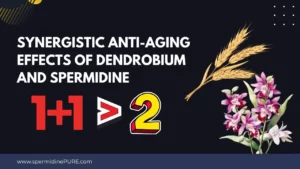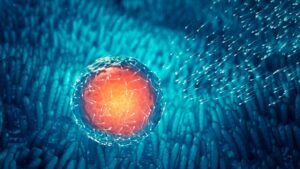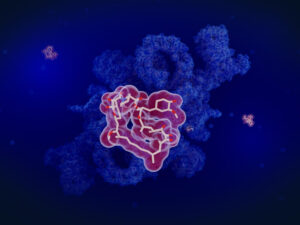Polyamines are organic compounds containing more than two amino groups that play essential roles in various cellular processes. Standard polyamines are found in all living organisms, including putrescine, spermine, and spermidine, which are synthesized from L-ornithine or by the decarboxylation of amino acids (source). These polycationic alkylamines exist in mammalian cells at millimolar concentrations and contribute to cell growth, development, and overall regulation of various cellular responses.
Among the benefits of polyamines, inducing autophagy is notable, as it promotes cellular renewal by eliminating old proteins and organelles that are no longer valuable (source). This process is crucial for maintaining a healthy immune system, supporting brain health, and potentially prolonging life. Balanced polyamine metabolism is vital, as abnormalities may be linked to several diseases, including cancer, neurodegenerative conditions, and inflammatory disorders (source).
Understanding the role of polyamines and their metabolism paves the way to explore potential therapeutic interventions in human disease management. Furthermore, increasing the intake of polyamine-rich foods can help individuals maintain proper polyamine levels and reap their benefits in cellular health and overall well-being.
What are Polyamines?
Polyamines are organic compounds containing more than two amino groups. These compounds are essential for the growth and development of all living organisms, including plants and animals. They play crucial roles in various cellular processes and are involved in responding to environmental stresses and diseases(Polyamines Lab).
Types of Polyamines
There are several types of polyamines. The most common and important ones include Putrescine, Spermidine, and Spermine. These polyamines are synthesized from L-ornithine or by the decarboxylation of amino acids. They can be found in all living cells(Polyamines: Functions, Metabolism, and Role in Human Disease Management).
Common Polyamines and Their Structures
The following are the most common polyamines with their respective structures:
- Putrescine: NH2(CH2)4NH2
- Spermidine: NH2(CH2)3NH(CH2)4NH2
- Spermine: NH2(CH2)3NH(CH2)4NH(CH2)3NH2
Spermidine and Polyamines
Spermidine is one of the major polyamines synthesized from L-ornithine. It plays essential roles in cell growth, gene regulation, and differentiation. Alongside other polyamines, spermidine facilitates various cellular responses in living organisms(Polyamines: Functions, Metabolism, and Role in Human Disease).
Biological Function
Polyamines play a vital role in the following biological processes:
- Cell growth and proliferation
- Gene expression and regulation
- Protein synthesis
- Maintenance of chromosomal structure and function
- Modulation of ion channels and enzyme activities
Abnormal polyamine metabolism has been associated with several diseases, including cancer, neurological disorders, and cardiovascular problems(Polyamines: Functions, Metabolism, and Role in Human Disease Management).
| Physical and Chemical Features | Description |
|---|---|
| IUPAC name | N-aminopropyl-1,4-diaminobutane |
| Other names | Spermidine |
| CAS Number | 124-20-9 |
| Chemical formula | C7H19N3 |
| Molar mass | 145.25 g/mol |
| Appearance | Colorless, hygroscopic solid |
| Density | 0.97 g/cm3 |
| Melting point | 24-27°C |
Biosynthesis and Metabolism
Polyamines (PAs) are organic polycationic alkylamines that are crucial in diverse cellular processes. The biosynthesis of polyamines, such as putrescine, spermidine, and spermine, begins with the amino acid L-ornithine, which is derived from arginine in liver cells.
Key Enzymes Involved in Polyamine Synthesis
The ornithine decarboxylase (ODC) catalyzes the conversion of ornithine to putrescine. Putrescine, in turn, serves as a precursor for producing spermidine and spermine, involving further enzymatic reactions. Spermidine synthase catalyzes the aminopropylation of putrescine to spermidine, while spermine synthase carries out the same reaction to synthesize spermine from spermidine.
Regulation of Polyamine Metabolism
Regulation of polyamine metabolism is essential for maintaining cellular homeostasis, as these molecules are involved in multiple cellular processes such as growth, survival, and differentiation. The activity of ODC is regulated at multiple levels, including transcription, translation, and post-translational modifications.
One major regulatory mechanism is the feedback inhibition of ODC by spermidine and spermine. These molecules bind to the enzyme, inhibiting its activity and impacting the overall synthesis of polyamines. Additionally, ODC is subject to proteasomal degradation, adding another layer of control to polyamine levels within the cell.
Furthermore, polyamine levels can be regulated through transport mechanisms and interconversion between polyamines. This interconversion is mediated by enzymes such as spermine oxidase and polyamine oxidase, which can convert spermine back to spermidine and spermidine back to putrescine, respectively.
In conclusion, polyamine biosynthesis and metabolism are complex processes that involve several key enzymes and regulatory mechanisms to maintain cellular homeostasis. Dysregulation of these processes can lead to various diseases and disorders, highlighting the importance of understanding the intricacies of polyamine metabolism in human health.
Polyamines in Human Health
Role of Polyamines in Growth and Development
Polyamines, such as putrescine, spermine, and spermidine, are essential for cellular growth and development in living organisms, playing a vital role in processes like DNA and RNA synthesis, protein synthesis, and stabilization of cell structures (source). These organic polycationic alkylamines are synthesized from L-ornithine or by the decarboxylation of amino acids (source).
Polyamines and the Immune System
Polyamines are involved in the immune system’s regulation, facilitating cell growth and proliferation and contributing to the modulation of immune responses. This influence on the immune system includes maintaining ion channels, which are crucial for essential cellular functions and communication between cells.
Polyamines in Neurological Health
The involvement of polyamines in the nervous system is crucial to neurological health, with a significant role in regeneration and aging. Spermidine, for example, has been investigated for its age-related changes in expression within the rat retina, indicating the importance of polyamines in maintaining neuronal function (source).
Polyamines and Cancer
Polyamines have been examined for their role in cancer development and progression, particularly in regards to cell growth and survival. They are essential for various cellular processes and have been linked to breast cancer and other types of cancer. Alterations in polyamine metabolism can lead to issues that contribute to the progression of tumors and support tumor growth (source).
However, polyamines may also have potential therapeutic applications in cancer treatment, as their inhibition can lead to reduced cell growth. Targeting polyamine metabolism might provide opportunities for developing new therapeutic strategies in cancer management.
Polyamines in Disease
Polyamines play crucial roles in various cellular processes, and their dysregulation is associated with various diseases. This section explores the involvement of polyamines in inflammation, infectious diseases, cardiovascular diseases, and neurodegenerative diseases.
Polyamines and Inflammation
Polyamines are essential in the regulation of inflammation. They participate in macrophage activation and cytokine production (source). Dysregulation of polyamine metabolism can lead to chronic inflammation, contributing to various human diseases.
Polyamines and Infectious Diseases
Both bacteria and viruses require polyamines for their replication and survival. As a result, targeting polyamine metabolism has emerged as a potential strategy for treating infectious diseases. Polyamines also play a role in host immune responses during infection (source).
Polyamines and Cardiovascular Diseases
Alterations in polyamine levels have been linked to cardiovascular diseases, including hypertension and atherosclerosis. Polyamines are involved in vascular smooth muscle cell proliferation and endothelial function, and their dysregulation may contribute to the development of cardiovascular diseases (source).
Polyamines and Neurodegenerative Diseases
Polyamine metabolism has also been implicated in neurodegenerative diseases such as Alzheimer’s disease, Parkinson’s disease, and cerebral stroke. Polyamine catabolism generates reactive oxygen species, which can contribute to neuronal damage and cell death. Furthermore, alterations in polyamine levels might affect autophagy, a key pathway involved in removing damaged proteins and organelles (source).
Factors Affecting Polyamine Levels
Various factors, including genetic, nutritional, and environmental aspects can influence polyamine levels. These factors determine the overall synthesis, metabolism, and consumption rates of polyamines in organisms.
Genetic Factors
One key genetic factor that affects polyamine levels is the eukaryotic translation initiation factor 5A (eIF5A). This protein is involved in initiating protein synthesis and has been found to be closely associated with polyamine metabolism. Mutations or dysregulation of the genes encoding eIF5A can significantly impact cell polyamine levels, influencing their biological roles and associated disease outcomes.
Nutritional Factors
Nutritional factors, such as dietary polyamine intake, can substantially influence polyamine levels within the body. A diet rich in polyamines, like those found in certain foods or supplements, can lead to elevated polyamine levels, while a diet low in polyamines can cause a decline in their concentrations. Moreover, certain nutrients and vitamins, such as vitamin B6, play a crucial role in polyamine metabolism, indirectly affecting their levels in the body.
Environmental Factors
Environmental factors, including stress, radiation, and toxins, can also affect polyamine levels. For example, cells subjected to genotoxic substances like ionizing or ultraviolet radiation may experience a depletion of polyamines, increasing their sensitivity to damage. Other environmental factors like pathogenic components of the gastrointestinal microbiota can also influence polyamine levels within the epithelial tissue, contributing to the overall polyamine concentration in the body.
Measuring Polyamines
Polyamines are organic polycationic alkylamines found in all living cells, involved in processes such as translation and signaling. Their accurate measurement is crucial in understanding their role in biological systems and their potential clinical applications.
Methods of Measuring Polyamines
One common method for measuring polyamines is the Total Polyamine Assay Kit, which rapidly determines polyamine concentration in biological samples. This kit uses a selective enzyme mix to generate hydrogen peroxide, which then reacts with a fluorometric probe to yield a signal proportional to the amount of polyamine present.
Another approach to measure polyamines is by analyzing them as their benzoylated derivatives. This process involves extraction and reaction with benzoyl chloride, followed by vortex stirring. The benzoylated polyamines can then be detected and quantified using chromatographic techniques.
High-performance liquid chromatography (HPLC) is a widely-used technique for polyamine determination. The HPLC system typically consists of modules such as a vacuum degasser, gradient pump, autosampler, and diode array detector.
Clinical Applications
Polyamines are related to various biological functions and health conditions, and their measurement in clinical settings has several implications. For instance, blood polyamine concentrations are often increased in cancer patients due to active polyamine synthesis; therefore, assessing whole blood polyamine levels could aid in detecting and monitoring cancer.
In addition to cancer, polyamines also play a significant role in managing other human diseases, such as metabolic disorders and neurological conditions. Accurate measurement of polyamines in patients can help clinicians provide better treatment strategies and personalized therapy.
Polyamines as Therapeutic Targets
Polyamines are essential components of cells that play crucial roles in normal cellular growth and function. As such, they have emerged as significant therapeutic targets for various diseases, particularly in cancer treatment.
Drugs Targeting Polyamines
Several compounds have been developed to interfere with polyamine biosynthesis or function, exhibiting potential as therapeutic agents. Among the important drug targets in polyamine metabolism are the enzymes ornithine decarboxylase and s-adenosylmethionine decarboxylase.
One of the well-known polyamine-inhibiting drugs is agmatine, a natural compound derived from the amino acid arginine. Agmatine functions as an antagonist of the polyamine biosynthesis pathway. It has been demonstrated to interfere with the production of nitric oxide, a molecule involved in various physiological processes and pathological conditions.
Potential Benefits and Risks
Inhibiting polyamine metabolism has shown promise in treating diseases caused by parasitic protozoa and certain types of cancer, as evidenced by the dual targeting of polyamine synthesis and uptake in animal models of diffuse intrinsic pontine glioma (DIPG).
However, targeting polyamines for therapeutic intervention also presents potential risks. Since polyamines play a crucial role in maintaining nucleic acid and chromatin structure, ion channel regulation, and protein synthesis, inhibiting their metabolism could lead to unintended adverse effects on cellular function and overall health. Therefore, careful consideration of the balance between potential benefits and risks is essential when developing therapies that target polyamines.
Conclusion
Polyamines, such as putrescine, spermine, and spermidine, play significant roles in various cellular processes, impacting human health and diseases. This section highlights the importance of polyamines in human health and provides suggestions for future research directions.
The Importance of Polyamines in Human Health and Disease
Polyamines are essential for cell growth and development, influencing essential processes such as transcription and translation. In human health, they support cellular and genetic metabolism. Furthermore, polyamines also participate in critical physiological processes related to stress responses, particularly in plants, where they aid in abiotic stress protection.
In diseases, polyamines may exhibit both beneficial and detrimental effects. For example, their role in cell proliferation may contribute to cancer development. Conversely, they may also protect against some illnesses, such as intestinal disorders, where symbiotic polyamine metabolism is observed.
Future Research Directions
Understanding polyamine metabolism and its influences on various diseases is critical for developing novel therapies and prevention strategies. Research should focus on unraveling the complex interactions between polyamines and disease pathways, possibly uncovering new targets for potential treatments.
Additionally, since polyamines modulate plant stress responses, investigations into their roles in human stress responses may uncover new physiological mechanisms and beneficial applications in human health. Furthermore, exploring the potential of polyamines as smart delivery systems in drug development may lead to innovations in medicine, particularly in increasing drug efficacy while decreasing side effects.
Finally, considering the role of polyamines in host-microbiota interactions, research on the influence of dietary interventions and probiotics on polyamine metabolism could contribute to developing personalized nutrition strategies for disease prevention and therapy.
FAQs
What are the dietary sources of polyamines?
Polyamines are found in various food sources, mostly from plant and animal materials. They can be obtained through consuming fruits, vegetables, whole grains, meat, fish, and dairy products. Some specific examples include soybeans, peas, oranges, and fermented foods. Additionally, polyamines are involved in postharvest physiology, playing a role in maintaining the antioxidant system and shelf life of fruits, which can impact their dietary availability and human health benefits.
How are polyamines involved in aging and longevity?
Polyamines, such as spermidine and spermine, have been shown to exhibit anti-aging properties by promoting cellular maintenance and enhancing the body’s natural defense mechanisms against various stressors. They have been linked to improved longevity by stimulating autophagy, a cellular recycling process that removes damaged or non-essential components to maintain cellular health. Additionally, polyamines may contribute to reducing inflammation and regulating gene expression, impacting the aging process and overall health.
Can polyamines be synthesized in the body?
Yes, polyamines can be synthesized in the body. The main polyamines, including putrescine, spermidine, and spermine, are naturally produced in the human body through various metabolic pathways involving amino acids, such as ornithine and arginine. Moreover, certain enzymes, like cyclen, tris(2-aminoethyl)amine, and 1,4,7-triazacyclononane, play a crucial role in the biosynthesis of polyamines. These endogenous polyamines are essential for multiple biological functions, such as cell growth and differentiation.
Are there any dietary supplements that can boost polyamine levels?
While some dietary supplements claim to boost polyamine levels, it is essential to approach such supplements with caution. Consuming a well-balanced diet, rich in polyamine-containing foods, is the safest and most effective way to maintain appropriate polyamine levels in the body. Furthermore, it is always best to consult with a healthcare professional before trying any dietary supplements to ensure their safety and effectiveness for individual health needs.
Do polyamines have any role in virus infections?
Polyamines have been implicated in certain virus infections, as they play a vital role in cellular processes, which viruses can exploit for their replication and survival. Viral pathogens may alter polyamine metabolism in the host to benefit their life cycle. However, further research is needed to fully understand the specific mechanisms and potential therapeutic applications targeting polyamine pathways in the context of virus infections.



